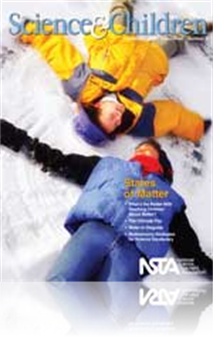All Resources
Journal Article
What’s the Matter With Teaching Children About Matter?
When it comes to learning about solids, liquids, and gases, children often bring interesting yet inaccurate ideas to the topic. When children’s ideas conflict with the concepts we seek to teach, they interfere with learning. Therefore, we must cons...
Journal Article
An Environmental Town Meeting: Balancing Environmental Decisions and Real-Life Issues
In order to help middle school students understand the many aspects that go into making decisions about environmental issues and concerns, as well as identifying the players involved in these decisions, an environmental town meeting activity was deve...
Journal Article
Calibrated Peer Review (CPR), an online program that purportedly helps students develop as writers and critical thinkers, is being increasingly used by science educators. CPR is an enticing tool since it does not require instructors to grade student ...
Journal Article
Scope on Safety: Clearing the air on ventilation
Poor ventilation is often a topic of conversation relative to safety concerns in school science laboratories. Too often, school science laboratories have ventilation systems that are inappropriate and ineffective for removing hazardous chemical vapor...
Journal Article
Issues In-Depth: How “bright” is it to use CFLs? A look at the controversy
Commonly referred to as CFLs, compact fluorescent light bulbs are rapidly replacing traditional incandescent light bulbs for residential use. However, controversy and even comic parody have arisen surrounding CFL use. CFLs contain small amounts of me...
Journal Article
Tech Trek: No need to weather the storm to collect data
At a time when climate change is at the forefront of the media and is a topic of worldwide scientific inquiry, it is critical to engage middle school science students in technology-based activities that integrate climate change into course instructio...
Journal Article
Building a Better Biology Lab? Testing Tablet PC Technology in a Core Laboratory Course
Tablet PC technology can enliven the classroom environment because it is dynamic, interactive, and “organic,” relative to the rigidity of chalkboards, whiteboards, overhead projectors, and PowerPoint presentations. Unlike traditional computers, t...
Journal Article
Science Sampler: Fueling interest in science—An after-school program model that works
As our society becomes more technologically advanced and jobs require additional related skills, it is important that all girls, not just those interested in science, technology, engineering, and math (commonly referred to as the STEM disciplines), t...
Journal Article
Editor’s Corner: A Look Back (2008)
The end of the year is always a time for reflection and looking back. Even though December may feel more like midyear for teachers, the end of the calendar year inevitably brings top 10 lists, reviews of the best the year had to offer, and vows for i...
Journal Article
Science Shorts: Comparing Liquids
Children experience the physical properties of liquids as they watch raindrops run down a window, observe how insects can walk on water, and notice how the “shape” of a liquid matches the container in which it is held. Thinking about similarities...
Journal Article
Career of the Month: An Interview With Astronomer/Astrophysicist Shep Doeleman
How did the first galaxies form? How old are the oldest stars? Much of the universe remains uncharted territory. As astronomers study the abundance of celestial objects and phenomena outside Earth’s atmosphere, they constantly make discoveries that...
Journal Article
Teachers and students alike deal with certain levels of anxiety. But how much is too much, and what can students do to cope? ...
Journal Article
Volunteer Scientist-in-the-Classroom Partnership in Metropolitan Nashville Public Schools
In 1897, long before the entertainment industry made Nashville famous with country music and the Grand Ole Opry, the city was known as the “Athens of the South,” with numerous institutions of higher learning. A century later, four of Nashville’...
Journal Article
Methods and Strategies: Concept-Focused Teaching
One of the main problems we face in science teaching is that students are learning isolated facts and missing central concepts. For instance, consider what you know about life cycles. Chances are that you remember something about butterflies and stag...
Journal Article
The Early Years: Air Is Not Nothing
Children usually begin to understand that a substance called air is all around us after age three, but they don’t grasp that air is matter until age five, or even older. They may learn that “air is a gas” but have difficulty naming the substanc...
Journal Article
Perspectives: Using Analogies in Elementary Science
Using analogies in science classrooms helps students make connections between everyday life and the concepts we are trying to teach. Analogies help students form a bridge between their existing knowledge and new knowledge. Humans use analogical reaso...






